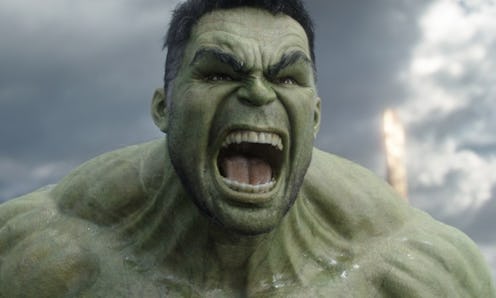Entertainment
Here's Why The Hulk Is Even Angrier Than Usual In 'Thor: Ragnarok'
The last we saw Bruce Banner, aka The Hulk (Mark Ruffalo), he was settling into a Quinjet at the end of Avengers: Age Of Ultron. Still in Hulk form, he listened to Black Widow's (Scarlett Johansson) attempt to calm him down via video as the jet takes off. When Black Widow asked Hulk to turn on the jet's tracker so S.H.I.E.L.D could determine his location, Hulk instead shut off communications completely, and set off to an unknown destiny. So exactly what happened to Hulk at the end of Age of Ultron? And what of Bruce Banner, mild-mannered scientist trapped within?
Both characters' struggle for dominance and control, of themselves and their alter-ego, begins here and sets the stage for The Hulk's future story arc. The next time Hulk appears is over two years later, ripping loose to fight Thor in The Grandmaster's gladitorial arena in the latest Marvel movie, Thor: Ragnarok. Now, that's the key element — he's still The Hulk, and has remained so since we last saw him fly off. That's the longest The Hulk's remained as a consistent alternate personality in the entire Marvel series. Hulk only finally transforms back to Banner after (small spoiler ahead) Thor finds the same quinjet Hulk took and plays a recording of Black Widow for him. It's the first time Banner's resurfaced since the Avengers last saw him in Sokovia.
Ruffalo has said in several interviews that the focus from here on out is Banner and Hulk figuring out a balance between their conflicting personalities. Each are afraid of the other, of what the other is and can do to them. This may seem odd; it's easy to understand what Banner has to fear from The Hulk, but what could the seemingly invincible Hulk have to fear from Banner? One of Hulk's two lines from the first Avengers film says it all. Before transforming back, Hulk says of Banner, "Puny god." Hulk's entire existence hinges on a man whose own existence hinges on remaining mild-mannered, who's definitely not invincible and whose main contribution to the group is scientific.
Leader of S.H.I.E.L.D Nick Fury mentions in Avengers that the jet Hulk took off in landed near Fiji, a location with no particular significance in the Marvel universe. This has shades of the infamous "we stuck your girlfriend on an island" throwaway excuse explaining Natalie Portman's absence from the last Avengers movie, a convenient way to place a major character on the backburner until the storyline calls them back into the fray. In this case, keeping The Hulk safely out of the increasingly tangled storylines of Marvel movies until his reappearance in Ragnarok. There's little explanation as to how Hulk flew the quinjet he supposedly abandoned to swim to Fiji all the way out to the garbage planet of Sakaar. The only important element is, he's been the Hulk this entire time.
As Ruffalo himself said in a Collider interview, "the more [Banner] turns into the Hulk, the more established the Hulk becomes in his identity," meaning the confidence Banner and the Avengers place in The Hulk as ace in the hole will eventually backfire on them, as Hulk becomes a person in his own right. In Ragnarok, Hulk's development isn't complete, with Banner's personality leeching into Hulk's. In an interview with Yahoo! Entertainment, visual effects supervisor Jake Morrison explains how Hulk's appearance was modified to more closely resemble Ruffalo/Banner, reflecting Ruffalo's more prominent voice acting work speaking as Hulk.
With The Hulk, not Banner, taking the wheel at the end of Ultron, we're seeing the next step in Hulk's established, separate identity. The nature of Banner and Hulk's duality, that one can't exist while the other does, but for now, Banner can exist without the Hulk, sets up a tension that promises to deliver down the line in future Marvel movies.
